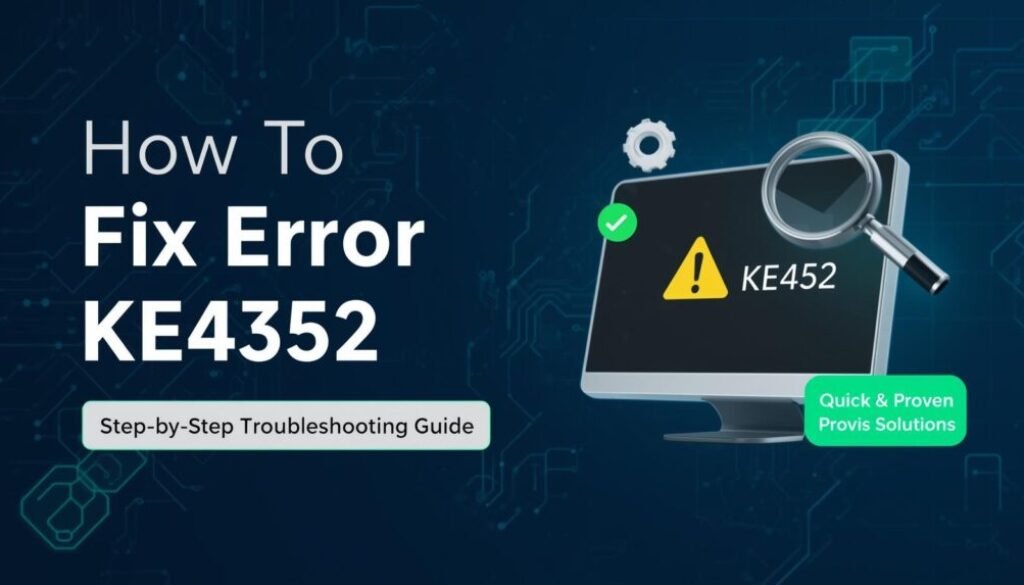How to Fix Error KE4352 Error Code: Step-by-Step Troubleshooting Guide
Introduction: What is the KE4352 Error Code?
Facing the KE4352 error code can be annoying. It might stop your work or disrupt your system. This error usually means there are corrupted files, incompatible drivers, or software issues. It can happen on various platforms, like Windows PCs, external devices, or certain software applications.
Error KE4352 usually shows up when the system can’t process a command. It can also happen due to communication problems between the software and hardware. The good news is it can be fixed. Just follow some simple troubleshooting steps.
Common Causes of Error KE4352
Before we dive into the fixes, let’s first look at what causes the KE4352 error. Identifying the trigger can help you apply the most relevant solution.
- Corrupted System or Program Files – Damaged or missing files often cause this error to appear.
- Outdated Drivers – Old or incompatible drivers can stop devices or software from working right.
- Software Conflicts – Two programs trying to access the same resource may lead to a KE4352 conflict.
- Hardware Malfunctions – Faulty cables, USB ports, or damaged devices may also trigger this code.
- Incomplete Updates – Interrupted OS or software updates can corrupt installation files.
- Registry Errors – Misconfigured registry entries can cause certain processes to fail during startup.
Preventing future issues and keeping the system stable is possible by tackling these causes step by step.
Step-by-Step Guide to Fix Error KE4352
Follow these proven troubleshooting steps to resolve the KE4352 error code effectively.
Step 1: Restart Your System
A simple system restart can fix temporary glitches. Restarting clears the cache and refreshes memory. This often fixes small bugs that cause error KE4352.
- Close all running applications.
- Restart your device normally.
- Recheck if the error persists.
If the problem reappears, move on to deeper troubleshooting.
Step 2: Update Your System and Drivers
Outdated drivers and software can create communication problems that cause KE4352.
For Windows Users:
- Press Windows + I → Open Settings.
- Go to Windows Update → Click Check for updates.
- Install all available updates.
For Drivers:
- Press Windows + X → Select Device Manager.
- Expand the hardware category and right-click on the device.
- Choose Update driver → Search automatically for drivers.
After updates are complete, restart your system. This resolves many instances of error KE4352 related to outdated components.
Step 3: Run System File Checker (SFC) and DISM Tools
Corrupted system files are among the top reasons for the KE4352 error. Running built-in repair tools can help restore missing or damaged files.
- Open Command Prompt as an Administrator.
Type the following command and press Enter: sfc /scannow
- Wait for the scan to complete and follow any prompts to repair files.
If the issue persists, run the DISM tool:
DISM /Online /Cleanup-Image /RestoreHealth
After both scans are completed, restart your computer and test again.
Step 4: Reinstall the Affected Software
If KE4352 appears when launching a specific program, reinstalling it may fix the issue.
To reinstall:
- Go to Control Panel → Programs → Uninstall a program.
- Select the application causing the error and click Uninstall.
- Restart your computer.
- Download the latest version of the software from its official website and install it again.
This ensures that no corrupted files remain in the system.
Step 5: Check Hardware Connections
If you get the KE4352 error with external devices like a printer, scanner, or USB drive, check the physical connections.
- Ensure cables are firmly connected.
- Try different USB ports.
- If available, test the device on another computer.
If the device works elsewhere, the issue may be software-related on your primary system.
Step 6: Perform a Clean Boot
A clean boot starts Windows with minimal startup programs and services. This helps determine if background software is causing the KE4352 conflict.
- Press Windows + R, type msconfig, and hit Enter.
- In the System Configuration window, go to the Services tab.
- Check Hide all Microsoft services, then click Disable all.
- Go to the Startup tab → Open Task Manager → Disable all startup items.
- Restart your computer.
If the error no longer appears, one of your startup programs is the culprit.
Step 7: Run a Full Malware Scan
Malware or viruses can interfere with system processes and cause errors like KE4352.
- Use Windows Defender or a trusted antivirus tool.
- Perform a full system scan and quarantine or remove any threats detected.
- Restart your system afterward.
Keeping your system clean helps prevent many technical issues.
Step 8: Restore System Settings
If you made system changes or installed updates before the KE4352 error, try doing a System Restore.
- Type System Restore in the search bar.
- Open Create a restore point → Click System Restore.
- Choose a restore point before the issue started.
- Follow on-screen prompts to restore.
After restoration, check whether the error is resolved.
Advanced Solutions
If the error still persists after following all the steps above, consider the following advanced fixes:
- Reset Windows settings while keeping your files intact.
- Reinstall your operating system as a last resort (after backing up important data).
- Contact manufacturer support if the error is related to specific hardware or software.
Prevention Tips for KE4352 Error
Once the issue is resolved, follow these preventive measures to avoid future occurrences:
- Regularly update drivers and software.
- Keep your system free of junk files using disk cleanup utilities.
- Avoid force shutdowns while software updates are running.
- Use reliable antivirus software to block malware threats.
- Perform system backups before major updates or installations.
Proactive maintenance ensures your computer remains stable and error-free.
Conclusion
The KE4352 error code seems tricky, but it’s usually easy to fix. Just follow the right troubleshooting steps. Corrupted files, outdated drivers, or software conflicts can cause issues. The step-by-step solutions above can help fix your system.
Start with simple fixes like restarting or updating drivers. If needed, try advanced solutions like file repair or system restoration. Keep your system updated and secure. This helps prevent error KE4352. You’ll enjoy smoother and more reliable performance.
FAQs About Fixing Error KE4352 Error Code
1. What does the KE4352 error code mean?
The KE4352 error code generally indicates a system or application malfunction caused by corrupted files, outdated drivers, or hardware communication issues. It’s a common error that can appear during software startup, system boot, or when connecting external devices.
2. How can I fix the KE4352 error on Windows?
To fix error KE4352 on Windows, start by restarting your system, updating all drivers, and running the System File Checker (SFC) and DISM tools. If the problem persists, reinstall the affected software or perform a System Restore to revert to an earlier stable version of your operating system.
3. Can hardware problems cause error KE4352?
Yes. Faulty cables, damaged USB ports, or malfunctioning devices can trigger error code KE4352. Always check physical connections, replace defective cables, and ensure the device works on another computer to confirm whether the issue is hardware-related.
4. Is it safe to ignore the KE4352 error code?
No, ignoring KE4352 is not recommended. The error may indicate deeper issues such as file corruption or driver incompatibility. Over time, this can lead to system instability, data loss, or more frequent crashes. It’s best to address the issue promptly using proper troubleshooting steps.
5. How can I prevent the KE4352 error from happening again?
To prevent KE4352 from recurring, keep your operating system and drivers updated, use trusted antivirus software, and perform regular system maintenance. Also, avoid interrupting updates or turning off your PC during installations to prevent file corruption.



